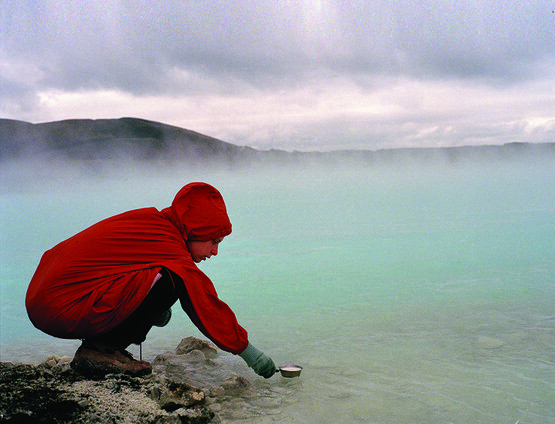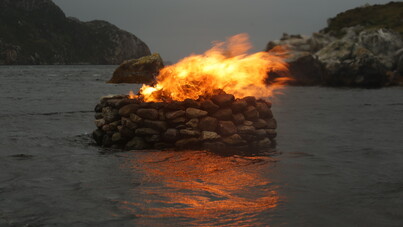

Julie Brook: What is it that will last?
by Greg Thomas
Reviews /
Exhibition
• 21.06.2023
In the refurbished vestibule of Abbot Hall, Kendal – a Georgian country estate converted into an art gallery in the 1960s – the sound of heavy water slapping on boulders echoes from an invisible source. The venue, which is managed by Lakeland Arts, has just reopened to the public and its first exhibition is a set of films, photographs and sketches by the land and tidal artist Julie Brook (b.1961). The noises are coming from the ground-floor gallery, in which the artist’s film Firestack, Night, Day 3 FIG.1 is playing. One in a series of works named after Brook’s firestack constructions, which bring together all four elements, the video shows close-up footage of gneiss boulders and flashes of Turner-esque light on water, accompanied by the intimate, muffled clang of hydrophones as they are dropped into the North Atlantic Ocean. The idea, the artist says, is to ‘slow you down, take you into another space, ready for the rest of the show’.1
Indeed, all of Brook’s work could be said to take us into another space: a strangely familiar one, in which we seem to experience the natural elements for the first time. Her firestacks are littoral constructions that the artist represents across other media, such as charcoal drawings, photographs FIG.2 and video. Brook began making these structures in 2016 on the isolated west coast of Lewis in the Outer Hebrides FIG.3, inspired by a prototype that she constructed in the early 1990s. At low tide, the artist builds a cylindrical dry stone tower with a cavity at the top, in which driftwood is placed and set alight. As the tide meanders or thunders in, the artist wades or rafts out to refuel the fire in the stone cairn, until finally the stack is consumed and the flames are snuffed out. Steam rises; a fizz carries across the shore. On a calm day, the stack may survive, whereas on a stormy day, the whole edifice may come crashing down before water and flame have become acquainted. They are seasonal works and the dance of the elements is an aleatoric element of the score.
Documentation of the firestacks, which are arguably Brook’s most potent creation, is complemented by gallery works evoking other remote sculptural interventions. Winter Wall FIG.4, a circular, hollow, dry stone tower with a vertical slit through which a body can squeeze, was made in 2019 on Aird Mhòr, Outer Hebrides. The aperture is designed to receive passing sunlight, particularly the midwinter setting sun. In the exhibition, the piece is represented by photographs and a small sketch in watercolour, gold-leaf and charcoal, which captures the threadlike form of the rays cast on a carpet of moss. Ascending FIG.5 is a narrow stone staircase built in the Kanagaso Quarry in Japan, made from discarded quarried stones. The steps lead towards a sheer, human-made cliff and, cast in the yellow stone of the site, are almost invisible from certain angles. In the gallery, two large works in ochre pastel on paper recreate the shape and colour of the stairs FIG.6. Parallel Space (2018), built in Japan’s underground Takigahara Quarry, consists of a section of wall created from blocks of tufa, which is mined in the deep tunnel. Set almost a body’s width in front of the far-larger quarry-face, it creates a cramped walkway of shadow which, Brook states, ‘is itself the artwork’.2 At Abbot Hall, it is represented by two films, Parallel Space FIG.7 and Resistance, Yield (2019).
These works take their place in a tradition of land art. However, as the co-curator Simon Groom notes in a book published to coincide with the exhibition, for Brook, unlike some other land artists, ‘it is the landscape that suggests form, rather than the imposition of a preconceived form on the landscape’ (p.12).3 One might go further and note that the pre-existing environment often remains the key source of attention in Brook’s work. In Parallel Space, for example, the constructed element could be seen as a synecdoche for the walls of the vast cavern in which it is placed. Similarly, Ascending grants a sense of surmountability to an existing vertical plane – it is in some crucial way a variation or riff on the physical dynamics of the quarry. In the firestack series and Winter Wall, the responsiveness to location is less evident in their physical form, than in their function as timepieces or gauges for measuring water, sunlight, shadow or wind, focusing the attention of the viewer on the wild setting as an all-encompassing sensory and aesthetic entity.
Moreover, the site-specificity of Brook’s work is complemented by a time-specificity that foregoes the immutable, edifice-like quality of some land art. To experience a firestack being toppled, or sunlight slipping through Winter Wall, is to partake in a durational experience that will end at a point dictated by season, climate and other variables stage-managed by the artist. In a 2018 essay, Brook notes that the power of the firestacks ‘is their choreography of time’ (p.12). The effect seems less significant in the two works in Japan, perhaps, but both constructions invite temporal human intervention: the steps at Kanagaso call out to be ascended and descended, the gloomy passageway at Takigahara to be squeezed through. In the remarkable Resistance, Yield the Butoh dancer Kae Ishimoto brought to life three distinct spaces in and around the work: the front, top and rear of the wall. Her movements, by turns jerking, yearning and straining, suggest a quixotic desire to shift the enveloping mountain, pitting human flesh and will against the obduracy of stone.
By erecting sculptural interventions that will, in many cases, be swallowed up by the landscape, Brook’s art is also vitally concerned with human interaction with the natural world: not just nature, but being in nature. An extraordinary story relayed by Robert Macfarlane in the accompanying publication provides some biographical context to this impulse:
Between 1990 and 1994, Julie Brook lived alone in a natural stone arch on the west coast of Jura in the Inner Hebrides. She slept in a cloth and driftwood structure at the back of the arch, behind a wind-baffle built to soften the bite of the Scottish weather, and made work – paintings, sculptures – in response to the natural world in which she had chosen to dwell (p.76).
It is notable that much of this exhibition consists of footage of the artist, often with teams of friends and advisors, heaving stone across uneven terrain, in brutal heat or biting cold. In the film Ascending, for example, Brook forms a diverting, non-linguistic bond with a Japanese farmer who decides to help make the stairway FIG.8. Her sculptures, films and paintings emerge from a prior psychophysical engagement with the world. Groom describes the creation of her work as ‘acts of doing, of immersion in a landscape […] a giving oneself over entirely to the action necessary to complete a task’ (p.12).4
The artist’s role in the construction of the works finds a parallel with the new awareness of self in relation to environment that the audience is given by the encounter with it. We are not invited to forget ourselves in sublime spectacle, but somehow to realise afresh how our thinking and feeling bodies inhabit that spectacle. Recounting his own experience of watching the immersion of a firestack in water, Macfarlane writes:
I found myself responding physically; straightening my back, reaching my neck and lifting my head higher, as if in a fast-filling submarine chamber […] This effect – of vicarious bodily mimicry – is what William Golding memorably called ‘sympathetic kinaesthesia’ […] Brook’s work activates a sympathetic kinaesthesia between bone and stone, between flesh and fire (p.81).
While the viewer encounters most of Brook’s sculptures at one remove in What is it that will last?, a new site-specific work has also been created, twenty miles south of Kendal, in the gardens of Holker Hall, Cark FIG.9. A vast pile of Cumbrian black slate sits in the lee of landscaped folds. From a distance it suggests grand, primordial chaos, but when one approaches, a stone walkaway becomes visible. One can walk up and down the sculpture, using it as a platform to survey the surrounding copse, before walking away and, looking back, seeing it revert into a pile of indistinguishable stone. Human-made order, hard-won, physically demanding and temporary, emerges briefly from the jaggedness of rock, then recedes.
Exhibition details
Julie Brook: What is it that will last?
Abbot Hall, Kendal
20th May–30th December 2023
Footnotes
- Julie Brook, in conversation with the present author, 18th May 2023. footnote 1
- Ibid. footnote 2
- Accompanying publication: What is it that will last? Land and tidal art of Julie Brook. By Julie Brook, Simon Groom, Alexandra Harris, Raku Jikinyū and Robert Macfarlane. 144 pp. incl. 120 col. ills. (Lund Humphries, London, 2023), £39.95. ISBN 978–1–84822–644–9. footnote 3
- Emphasis in original quotation. footnote 4



_still.jpg)
.jpg)




_ still.jpg)
 _still_2.jpg)
.jpg)

